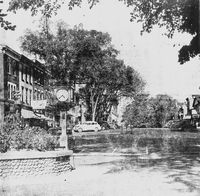Subscriptions
Menu
Advertisements
Old Cobleskill lithograph "one of the best"
7/6/2011 |

Writers occasionally compose opinion pieces--editorials and columns, for instance--in the first person, but news stores almost never are in that style.
Except this time.
My wife Sandy and I informally agreed several years ago not to exchange gifts for Mother's and Father's days, but this year Sandy surprised me with a gift so unusual that it deserves a story.
And appropriately, the gift stretches back in this newspaper's history.
The gift is a brass lithograph plate of a photo of Main Street, Cobleskill, from the late 1930s or early '40s.
It's 8.5 inches square, and the flattened brass rim is carefully nailed to a wooden block, as newspapers would have used 70-some years ago.
How Sandy came across it is a good story.
As an agent for Realty USA, she was listing a house that belonged to Tom Scholet's mother in Richmondville about a month ago.
Tom was going through papers and showed Sandy a letter he had written to his mom, and she had saved it.
Tom had used the lithograph to make letterhead and had written the letter on it.
Sandy liked the letterhead, and Tom explained that as a boy, he had been hired by The Cobleskill Times to clean out the basement.
He threw most of the stuff out but kept the lithograph because he liked it.
As Sandy and Tom talked, she told him that she and I owned the Times-Journal, the company that evolved from The Times.
Tom had the plate at his home in Colorado but vowed to send it to Sandy.
"Lots of people say they'll do something and then just forget," Sandy said. "Tom didn't. It was just a very nice thing to do."
Nice, indeed, and the plate arrived just before Father's Day, so Sandy made it an impromptu present.
The question became what to do with the plate, because the engraving is shallow and difficult to see.
Jerry Mickle had the answer.
Now working part-time at the T-J, Jerry for years was the printing foreman and knew immediately how to use the plate.
He put it on the T-J's 15-by-20.5-inch old Heidelberg press and created the image shown here.
We no longer use the press for printing but occasionally crank it up for scoring and perforating commercial print jobs.
"That old girl probably hadn't been inked up in 20 years, but it still runs well," Jerry said.
He explained that The Times would have had the plate made at a more specialized shop.
The Times made engravings of photos for the paper, but the engravings were plastic and made on a machine called a Scanograver.
"This is a real good plate," Jerry said. "One of the best."
I agree.









